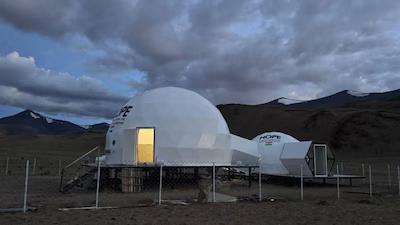
ISRO Sets Up Station in Ladakh to Simulate Life on Moon & Mars
In a groundbreaking move, the Indian Space Research Organisation (ISRO) has set up a unique station in the Tso Kar Valley of Ladakh to simulate life on the Moon and Mars. The Himalayan Outpost for Planetary Exploration (HOPE) is a 10-day simulation mission aimed at testing life-support systems for future lunar and Martian missions. Two crew members will undertake various tests at the facility from August 1-10, braving the harsh conditions of the valley.
The Tso Kar Valley was chosen for its extreme environment, which is eerily similar to the Martian terrain. The valley experiences high UV radiation, low atmospheric pressure, extreme cold, and saline permafrost, making it an ideal location for testing the feasibility of human life on the Red Planet. ISRO has set up a mini Mars-like environment at the HOPE station, complete with inflatable habitats, life support systems, and communication networks.
The simulation mission is designed to test the crew’s ability to survive and function in such an unforgiving environment. The crew will perform various tasks, including navigating through the terrain, conducting scientific experiments, and maintaining communication with the outside world. The mission will also assess the effectiveness of the life-support systems, including air, water, and food supplies.
The HOPE station is a significant milestone in India’s quest to explore space. ISRO has been working towards sending a manned mission to space in the near future, and the HOPE station is a crucial step in that direction. The success of this simulation mission will pave the way for future missions to the Moon and Mars.
The Tso Kar Valley is located at an altitude of 4,500 meters above sea level, making it one of the most remote and inhospitable regions in the country. The harsh weather conditions, including extreme cold, high winds, and limited communication infrastructure, make it a challenging environment for any human mission.
However, ISRO scientists are confident that the HOPE station will be able to withstand the harsh conditions and provide a safe and comfortable environment for the crew. The station is equipped with advanced life support systems, including air purification, water recycling, and waste management facilities.
The HOPE station is also designed to test the effectiveness of different communication systems, including satellite communication and radio communication. The crew will be able to communicate with the outside world through the ISRO’s satellite network, which will provide real-time updates on their mission.
The success of the HOPE station will not only pave the way for future space missions but also provide valuable insights into the challenges of living in space. The mission will also help to develop new technologies and strategies for future space exploration.
The HOPE station is a testament to India’s growing capabilities in space exploration. ISRO has made significant progress in recent years, including the successful launch of the Chandrayaan-1 mission to the Moon and the Mangalyaan mission to Mars. The HOPE station is another step forward in India’s quest to explore the vast expanse of space.
In conclusion, the Himalayan Outpost for Planetary Exploration (HOPE) is a significant milestone in India’s space exploration journey. The 10-day simulation mission will test the feasibility of human life on the Moon and Mars, and provide valuable insights into the challenges of living in space. The HOPE station is a testament to ISRO’s capabilities and a significant step forward in India’s quest to explore the cosmos.






